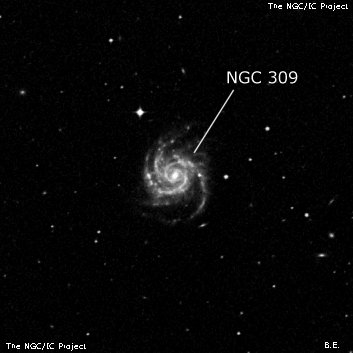
At a redshift distance of ~260 million light years, NGC 309 is one of the largest and most luminous spiral galaxies known.
Wilhelm Tempel discovered NGC 309 = T I-4 in 1876 with an 11" refractor at the Arcetri Observatory. His RA was 10 seconds too small. Bigourdan measured an accurate position on 26 Oct 1897 as well as by Howe in 1898-99 using the 20" refractor at Chamberlin Observatory.
Based on a photograph taken with the Reynolds reflector at the Helwan observatory, NGC 309 was described as a "open spiral with a pB sharp stellar nucleus, well defined arms and many condensations".
200/250mm - 8" (10/13/81): very faint, slightly elongated, even surface brightness.
400/500mm - 17.5" (10/28/89): fairly faint, fairly large, slightly elongated ~E-W, weak concentration. A mag 12.5 star is off the NNE edge 2.1' from center. A mag 15 star is off the west edge.
600/800mm - 24" (12/21/16): at 282x; fairly faint, moderately large, roundish, fairly low but uneven surface brightness, contains a brighter core that increases somewhat to the center. I detected hints of spiral arms in the halo (slightly brighter arcs). A mag 12.5 star is 2' NNE and a mag 15 star is off the west side, 1.5' from center. IC 1602, the brightest member of AGC 117, lies 13' WSW. It appeared fairly faint, small, round, 20" diameter, slightly brighter nucleus.
Notes by Steve Gottlieb